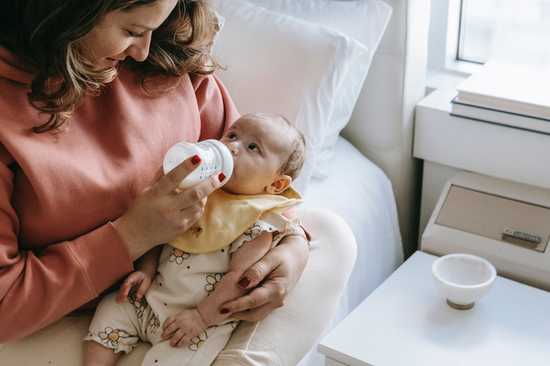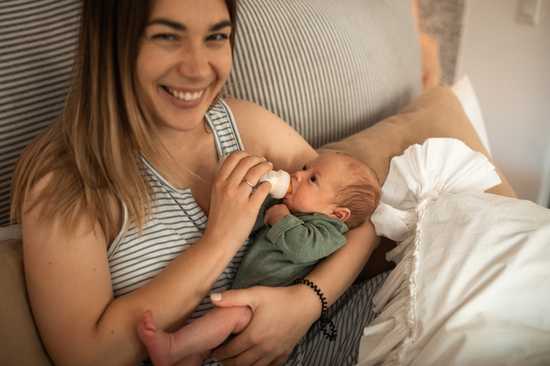When do you switch to size 2 nipples? Some babies will be perfectly content with size 1 nipples until they can switch to size 2 nipple flow. Other babies may need to switch sooner, depending on their rate of growth and appetite. This blog post will discuss when it is appropriate to switch from size 1 to size 2 nipples.

What Are The Types Of Nipples?
- Slow – A tiny aperture on a slow bottle feeding nipple allows very little milk to enter the baby’s mouth.
- The fast-flow nipple is designed for infants who want to eat quickly. It has the largest opening out of all the nipples, allowing your baby to consume more milk at once.
When Should You Change Your Nipples From Medium To Tiny Size 2?
Slow flow nipples are for babies younger than three months, medium flow (size 2) bottle nipple sizes fit infants aged six to ten months, and fast flow for those older than ten months.
One of the most recognizable symptoms of a sluggish flow is the time the baby takes to consume their bottle. If the baby takes longer than half an hour to finish a feeding, it may be time to make a change.
There is no specified time to switch bottle nipple sizes from 1 to 2 as each baby varies. Some babies are content using previous level nipples, but more voracious eaters may need to advance nipple levels sooner. When it’s time to switch from a level one nipple to the next level, usually there are telltale signs that the baby is unsatisfied with the current flow rate.
So, when do you switch to size 2 nipples? Several signs indicate a baby is ready to move up to the next level, which include:
- It is taking longer to finish a meal.
- When eating, becoming fussy or irritated.
- You should take several sucks on the straw before you swallow.
- When a baby is frustrated or may hit or slap the bottle.
- Frequently unclasping and re-clasping.
- You are forcefully flattening the nipple with your mouth.
- If your baby doesn’t finish the bottle but seems hungry shortly after feeding, or if they bite and pull at the nipple, these could be signs that they need a higher-flow teat.
Babies may, in some instances, take early solid foods. This might also be a signal to use a size 2 nipple flow. The pediatrician may recommend thickening of the infant’s milk at some stage.

Age-Appropriate Nipple Sizes
For Babies Who Are Breastfed
Parents who breastfeed need to be extra careful when choosing nipple sizes.
Start with the smallest-sized breast milk nipple available for your breastfed infant. They may cause them to become irritated and impatient while breastfeeding, which might lead them to cease accepting the breast.
For Babies Who Are Formula Fed
Bottles and nipples are usually supplied with instructions for the suggested nipple sizes at each age. The best indicators of what nipple size is ideal are still your baby’s feeding cues and behavior.
Start with the tiniest nipple size for formula-fed babies. Smaller or slower-flow nipples suit babies who can only consume 2 ounces at a time and have a minimal well-developed swallow reflex.
Ways To Tell A Bottle Nipple Is Too Big
Still, wondering when do you switch to size 2 nipples? When changing to a faster-flowing nipple, start with the one nearest to the old one. Other signs of the wrong flow rate include leakage from the corners of their mouth and rapid eating (five minutes or less).
Potential Issues You Might Face
Many parents face difficulties before their baby can fully adjust to the new size.
A faster milk flow, however, can be used to help with the child’s feeding problems. It may also create some difficulties.
If the condition persists, the parent should be cautious and consider returning to a single-nipple size.
Choking
The baby may choke on all the extra milk volume if the flow is too rapid.
Overfeeding
The baby may be unable to detect their natural fullness signals and consume more than they can handle. The newborn becomes restless and uncomfortable when stuffed.
Discomfort from gas or indigestion
If you are thinking, when do you switch to size 2 nipples? Reading any signals or changes in your baby’s feeding can be a wonderful hint. The baby may be ready for a size 2 nipple change by the time they are over 3 months old, although this is not always the case.
However, children at different ages children will react differently to the change. Be aware of all possible problems that could arise from the change to keep your baby as safe as possible.

Frequently Asked Questions
Q1: What is the best age to use a size 2 nipple?
Ans: The best age to use a size two nipple is when your baby is over three months old.
Q2: Are avent size 2 nipples different from comotomo?
Ans: The avent size two nipple is not different from the comotomo; they are both intended for babies who are over three months old.
Q3: How many bottle nipples should I buy?
Ans: You should buy at least four bottle nipples. Two for backup if you lose or damage them, and two for when your baby starts teething and chewing on them.
Q4: How is level 1 nipple different from level 2?
Ans: Level one nipple is for newborns, and level two nipple is for babies over three months old. Level two nipples have a faster flow rate than level one.
Conclusion
As your baby grows, their nutritional needs will change. A size two nipple has a faster flow rate than a size one and is intended for babies over three months old. If you’re unsure whether your baby is ready for a size two nipple, consult with your pediatrician. Remember to keep an eye on your baby while using the new nipple to ensure the flow rate is not too high. If you have any concerns, consult with your pediatrician.







